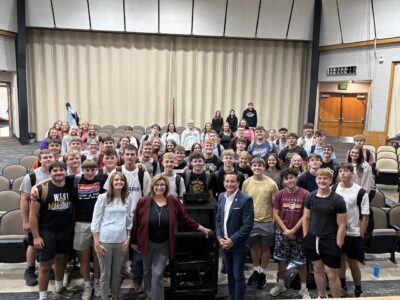Clean energy gives boost to Iowa economy

T-R photo by Stephanie Bowers — One of the Marshall County wind farms located in Laurel.
Wind energy is Iowa’s largest source of electricity.
With almost 30 wind farms all around the state it’s no wonder that wind has become a major influencer of Iowa’s economy.
“Iowa receives 42 percent of their energy from the wind which is the highest in the nation,” said Mak Heddens, Power Up Iowa deputy director. “Iowa receives $61 million in annual state and local taxes from wind farms and that money is then dispersed by county.”
Marshall County hosts about two different wind farms, one in Laurel and another near Vienna near the border with Tama County.
In 2010 the wind farm near Laurel was built. The project was approved by the county’s board of adjustment and has been active since 2011.
Laurel’s wind farm is approximately 11,000 acres disbursed in farm land. Under the wind farm is about 15 miles of electric and data collection cable.
Laurel’s mayor did not return calls from the T-R for comment.
The RPM Access’ wind farm generates about 121 megawatts of electricity using about 67 turbines.
Recently wind energy passed coal as Iowa’s primary source of electricity, accounting for more than 40 percent of the state’s energy.
According to the American Wind Energy Association Wind Powers America 2019 Annual Report, wind energy in Iowa creates more than 10,000 megawatts.
The money Iowa gets from wind farms helps fund infrastructure all around the state.
“It’s been really helpful for Iowa’s economy, especially rural Iowa,” Heddens said.
Wind energy has made a huge difference to Iowa rural counties, where many wind farms are found.
The emergence of wind power has created a ripple effect that is powering Iowa’s economy at record levels, according to information from Power Up Iowa. Wind projects grew by nearly $3 billion last year to reach a total of $19 billion in private investment, and Iowa remains a national leader in both jobs created within the wind industry and in manufacturing facilities in the wind energy supply chain.
Wind energy has become more popular through the decades to the point that Iowa’s landscape along major roads are lined with wind farms.
In a way wind farms have become as synonymous with Iowa as corn or soybean fields. “Where wind energy is harnessed, economic progress follows. For our most rural towns, wind is powering more of the economy every day,” said Bill Anderson, executive director of the Cherokee Area Economic Development Corporation. “Expanding the development of this reliable, homegrown energy source in rural America will only become more critical in the weeks, months, and years ahead.”
Iowa has been at the forefront of renewable energy and has seen benefits from its early start.
In 1983, Iowa became the first state in the nation to adopt a renewable portfolio standard, according to the U.S. Energy Information Administration. State regulators required Iowa’s two investor-owned electric utilities to own or to contract for a combined total of 105 megawatts of generating capacity that was powered by renewable energy.
Coal use overall in Iowa has gone from 59 percent six years ago to 35 percent in 2019.
Since 2008, Iowa has generated more electricity each year than the state consumed. Almost half of electricity retail sales in Iowa go to the industrial sector, nearly three-tenths of power sales are to the residential sector, and the commercial sector accounts for about one-fourth.
Wind energy has also helped move Iowa’s economic development forward.
“Developers want to come here, they want to develop here,” Heddens said. “Wind is a great resource in a place like Iowa. We have the workforce to accommodate that as well.”
In addition to the economic impact, wind energy has created 10,000 jobs in the wind industry.
“$69 million goes toward annual land lease payments to wind turbines on site,” Heddens said. “Wind energy has become a stable source of income for farmers.”
—–
Contact Thomas Nelson at tnelson@timesrepublican.com






